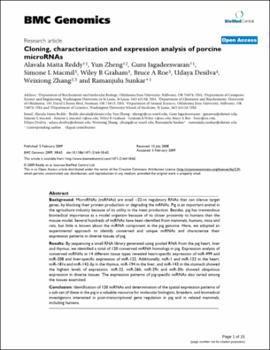| dc.contributor.author | Reddy, Alavala Matta | |
| dc.contributor.author | Zheng, Yun | |
| dc.contributor.author | Jagadeeswaran, Guru | |
| dc.contributor.author | Macmil, Simone L. | |
| dc.contributor.author | Graham, Wiley B. | |
| dc.contributor.author | Roe, Bruce A. | |
| dc.contributor.author | DeSilva, Udaya | |
| dc.contributor.author | Zhang, Weixiong | |
| dc.contributor.author | Sunkar, Ramanjulu | |
| dc.date.accessioned | 2018-11-09T21:10:52Z | |
| dc.date.available | 2018-11-09T21:10:52Z | |
| dc.date.issued | 2009-02-05 | |
| dc.identifier | oksd_reddy_cloningcharact_2009 | |
| dc.identifier.citation | Reddy, A. M., Zheng, Y., Jagadeeswaran, G., Macmil, S. L., Graham, W. B., Roe, B. A., ... Sunkar, R. (2009). Cloning, characterization and expression analysis of porcine microRNAs. BMC Genomics, 10, Article 65. https://doi.org/10.1186/1471-2164-10-65 | |
| dc.identifier.uri | https://hdl.handle.net/11244/302066 | |
| dc.description.abstract | Background: MicroRNAs (miRNAs) are small ~22-nt regulatory RNAs that can silence target genes, by blocking their protein production or degrading the mRNAs. Pig is an important animal in the agriculture industry because of its utility in the meat production. Besides, pig has tremendous biomedical importance as a model organism because of its closer proximity to humans than the mouse model. Several hundreds of miRNAs have been identified from mammals, humans, mice and rats, but little is known about the miRNA component in the pig genome. Here, we adopted an experimental approach to identify conserved and unique miRNAs and characterize their expression patterns in diverse tissues of pig. | |
| dc.description.abstract | Results: By sequencing a small RNA library generated using pooled RNA from the pig heart, liver and thymus; we identified a total of 120 conserved miRNA homologs in pig. Expression analysis of conserved miRNAs in 14 different tissue types revealed heart-specific expression of miR-499 and miR-208 and liver-specific expression of miR-122. Additionally, miR-1 and miR-133 in the heart, miR-181a and miR-142-3p in the thymus, miR-194 in the liver, and miR-143 in the stomach showed the highest levels of expression. miR-22, miR-26b, miR-29c and miR-30c showed ubiquitous expression in diverse tissues. The expression patterns of pig-specific miRNAs also varied among the tissues examined. | |
| dc.description.abstract | Conclusion: Identification of 120 miRNAs and determination of the spatial expression patterns of a sub-set of these in the pig is a valuable resource for molecular biologists, breeders, and biomedical investigators interested in post-transcriptional gene regulation in pig and in related mammals, including humans. | |
| dc.format | application/pdf | |
| dc.language | en_US | |
| dc.publisher | BioMed Central | |
| dc.rights | This material has been previously published. In the Oklahoma State University Library's institutional repository this version is made available through the open access principles and the terms of agreement/consent between the author(s) and the publisher. The permission policy on the use, reproduction or distribution of the material falls under fair use for educational, scholarship, and research purposes. Contact Digital Resources and Discovery Services at lib-dls@okstate.edu or 405-744-9161 for further information. | |
| dc.title | Cloning, characterization and expression analysis of porcine microRNAs | |
| osu.filename | oksd_reddy_cloningcharact_2009.pdf | |
| dc.description.peerreview | Peer reviewed | |
| dc.identifier.doi | 10.1186/1471-2164-10-65 | |
| dc.description.department | Biochemistry and Molecular Biology | |
| dc.description.department | Animal Science | |
| dc.type.genre | Article | |
| dc.type.material | Text | |
| dc.subject.keywords | miRNA family | |
| dc.subject.keywords | diverse tissue | |
| dc.subject.keywords | cloning frequency | |
| dc.subject.keywords | unique small RNAs | |
| dc.subject.keywords | intestinal epithelial cell differentiation | |
